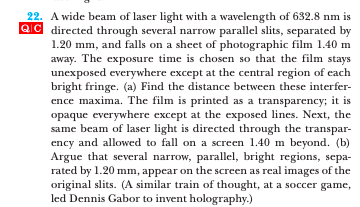A wide beam of laser light with a wavelength of 632.8 nm is directed through several narrow parallel slits, separated by 1.20 mm, and falls on a sheet of photographic film 1.40 m away. The exposure time is chosen so that the film stays unexposed everywhere except at the central region of each bright fringe. (a) Find the distance between these interfer- ence maxima. The film is printed as a transparency; it is opaque everywhere except at the exposed lines. Next, the same beam of laser light is directed through the transpar- ency and allowed to fall on a screen 1.40 m beyond. (b) Argue that several narrow, parallel, bright regions, sepa- rated by 1.20 mm, appear on the screen as real images of the original slits. (A similar train of thought, at a soccer game, led Dennis Gabor to invent holography.)
A wide beam of laser light with a wavelength of 632.8 nm is directed through several narrow parallel slits, separated by 1.20 mm, and falls on a sheet of photographic film 1.40 m away. The exposure time is chosen so that the film stays unexposed everywhere except at the central region of each bright fringe. (a) Find the distance between these interfer- ence maxima. The film is printed as a transparency; it is opaque everywhere except at the exposed lines. Next, the same beam of laser light is directed through the transpar- ency and allowed to fall on a screen 1.40 m beyond. (b) Argue that several narrow, parallel, bright regions, sepa- rated by 1.20 mm, appear on the screen as real images of the original slits. (A similar train of thought, at a soccer game, led Dennis Gabor to invent holography.)
College Physics
1st Edition
ISBN:9781938168000
Author:Paul Peter Urone, Roger Hinrichs
Publisher:Paul Peter Urone, Roger Hinrichs
Chapter27: Wave Optics
Section: Chapter Questions
Problem 18PE: Figure 27.56 shows a double slit located a distance x from a screen, with the distance from the...
Related questions
Question

Transcribed Image Text:22. A wide beam of laser light with a wavelength of 632.8 nm is
QIC directed through several narrow parallel slits, separated by
1.20 mm, and falls on a sheet of photographic film 1.40 m
away. The exposure time is chosen so that the film stays
unexposed everywhere except at the central region of each
bright fringe. (a) Find the distance between these interfer-
ence maxima. The film is printed as a transparency; it is
opaque everywhere except at the exposed lines. Next, the
same beam of laser light is directed through the transpar-
ency and allowed to fall on a screen 1.40 m beyond. (b)
Argue that several narrow, parallel, bright regions, sepa-
rated by 1.20 mm, appear on the screen as real images of the
original slits. (A similar train of thought, at a soccer game,
led Dennis Gabor to invent holography.)
Expert Solution
This question has been solved!
Explore an expertly crafted, step-by-step solution for a thorough understanding of key concepts.
Step by step
Solved in 4 steps

Knowledge Booster
Learn more about
Need a deep-dive on the concept behind this application? Look no further. Learn more about this topic, physics and related others by exploring similar questions and additional content below.Recommended textbooks for you

College Physics
Physics
ISBN:
9781938168000
Author:
Paul Peter Urone, Roger Hinrichs
Publisher:
OpenStax College

University Physics Volume 3
Physics
ISBN:
9781938168185
Author:
William Moebs, Jeff Sanny
Publisher:
OpenStax

Principles of Physics: A Calculus-Based Text
Physics
ISBN:
9781133104261
Author:
Raymond A. Serway, John W. Jewett
Publisher:
Cengage Learning

College Physics
Physics
ISBN:
9781938168000
Author:
Paul Peter Urone, Roger Hinrichs
Publisher:
OpenStax College

University Physics Volume 3
Physics
ISBN:
9781938168185
Author:
William Moebs, Jeff Sanny
Publisher:
OpenStax

Principles of Physics: A Calculus-Based Text
Physics
ISBN:
9781133104261
Author:
Raymond A. Serway, John W. Jewett
Publisher:
Cengage Learning